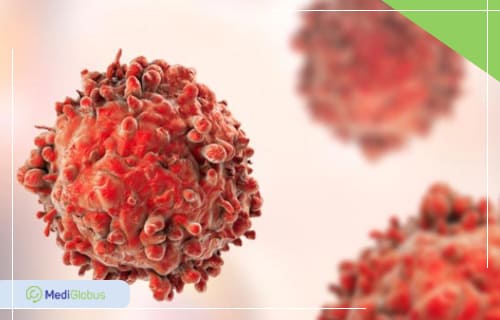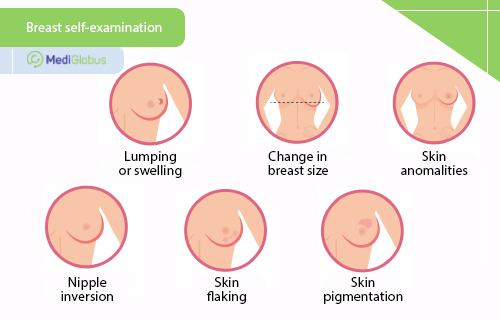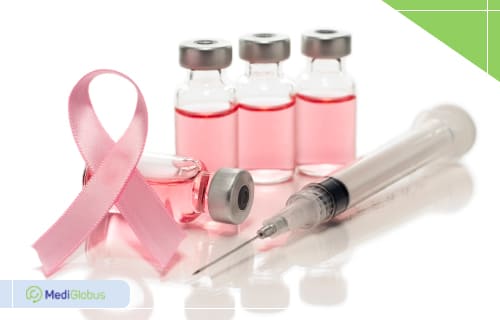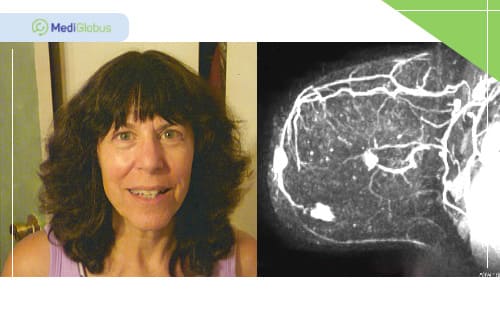| Breast angiosarcoma железы |
|---|
1. Diagnosing breast angiosarcoma
|
2. Treatment of breast angiosarcoma
|
3. Breast reconstruction
|
4. Patient story
|
5. Cost of treatment
|
Angiosarcoma of the breast is one of the rarest cancers. It accounts for less than 0,5% of all breast cancers. The oncological process occurs in the walls of blood or lymphatic vessels.
This disease is characterised by rapid development, and a tendency to form metastases and recurrences. Treatment is difficult, but with a timely intervention, there is a chance of survival. Learn from this article how patients with breast sarcoma are treated abroad.

Angiosarcoma of the breast is a rare and aggressive form of cancer that is difficult to treat.
The main method of treatment of angiosarcoma of the breast abroad is complete removal of the tissues affected by cancer. If the tumour is detected in the early stages, resection will be sufficient. At later stages, in the presence of metastases or recurrence, chemotherapy and radiation therapy are added to the standard course of treatment.
Good chances of recovery are observed in patients whose tumour was detected in the early stages. Therefore, all women over 30 years of age need to undergo an annual check-up with a mammologist and regularly check their breasts for neoplasms.
The five-year survival rate for primary breast angiosarcoma is 15-76%, depending on the stage of the disease. It is also important to consider the degree of malignancy – if it is low, most patients live more than 15 years in remission.
The five-year survival rate for radioinduced angiosarcoma of the breast is 43-88%.
A relatively positive prognosis is seen in breast sarcomas of low malignancy and with clear margins.
According to a study published in the American Journal of Roentgenology
Symptoms of angiosarcoma of the breast
Symptoms of angiosarcoma are similar to the manifestations of other breast cancers:
a lump in the breast area;
changes in the size or shape of the breast;
dimpling of the skin of the breast;
a change in the shape of the nipple, especially if it turns, sinks into the breast, or is irregularly shaped;
a rash or bruise on the breast or nipple;
a lump in the armpit area.

The average size of the tumour in angiosarcoma is about 4 cm. In most cases, the cancer process affects only one breast, but there are also cases of bilateral angiosarcoma.
Angiosarcoma can also cause changes in the colour of the breast skin.
Types of breast angiosarcoma:
The two main types of breast angiosarcoma are primary and secondary. Primary angiosarcoma occurs spontaneously and secondary angiosarcoma is a side effect of previous radiation therapy. However, this consequence of treatment is very rare.
Primary angiosarcoma of the breast:
Occurs most often in women 30-50 years of age;
A neoplasm with indistinct edges;
Tumours forms in the deeper tissues of the breast;
Occasionally affects the skin.
Secondary angiosarcoma of the breast:
Occurs in women 67-71 years of age;
Most often forms 5-10 years after radiation therapy;
Forms bruises on the surface of the breast, often painless.
Secondary angiosarcoma of the breast is more common than primary angiosarcoma.
Many patients are afraid to undergo radiotherapy due to the risk of developing secondary breast sarcoma, but we want to reassure them – the risk of this scenario is very low. Here’s what Professor Michael Wagner from the Fred Hutchinson Cancer Research Centre has to say about this: “In fact, angiosarcoma develops in less than one per cent of patients who have had radiotherapy.”
Metastasis in angiosarcoma most often affects the lungs. In rare cases, the cancer process infiltrates the lymph nodes.
How breast angiosarcoma is diagnosed

Often the diagnosis of angiosarcoma is delayed for a long time due to the ambiguity of symptoms and test results. Breast sarcoma is confused with other malignant and benign diseases. Because of this, treatment is started at later stages, worsening the prognosis.
Imaging techniques can help detect the neoplasm, which is very important in treatment planning, but a definitive diagnosis can only be made by biopsy.
Mammography
In most patients, the tumour is first detected using this method. On a mammogram, the sarcoma appears as an indeterminate mass, which distinguishes it from breast carcinomas. In rare cases, the tumour may appear as a “bubble” measuring about 4,5 cm.
MRI
In some cases, magnetic resonance imaging can detect tumours that are not visible on a mammogram. This examination method is sensitive to large clusters of blood vessels.
Biopsy
In primary angiosarcoma of the breast, a special needle is used for biopsy. The secondary form of the disease affects more superficial layers of tissue, so doctors use a scalpel or “pinch” biopsy.
Prognosis in angiosarcoma of the breast
Stage 1 | up to 76% |
Stage 2 | up to 70% |
Stage 3 | about 15% |
Treatment of angiosarcoma of the breast
Organ-preserving surgery
If the cancer is detected at an early stage, the tumour is small and tests give a good prognosis, doctors may be able to save the breast. In this case, only the tumour and the layer of tissue around it are removed to avoid recurrence. This surgery is possible in 25% of cases.

Mastectomy
During surgery, doctors completely remove the breast to avoid the risk of recurrence of the disease. In some cases, they may also remove lymph nodes.
Adjuvant therapy
A course of chemotherapy can increase the survival rate by up to 65%. Patients who have not been able to completely remove the cancer cells may be given radiation therapy.
Targeted therapies
There are some drugs, such as tyrosine kinase inhibitors and monoclonal antibodies, that have received FDA approval for use in treating breast angiosarcoma. These are taken along with chemo or throughout radiotherapy and increase their effectiveness.
Immunotherapy
Angiosarcoma of the breast began to be treated with immunotherapy less than 10 years ago. Research in this area is still ongoing, but it is already showing optimistic results. Up to a quarter of patients treated with immunotherapy for breast sarcoma achieve a significant reduction in tumour size.
Breast reconstruction after breast cancer

Although mastectomy is often the only way to save a patient’s life, the removal of the breast has a bad effect on a woman’s self-esteem and psychological state. In such cases, it is possible to perform breast reconstruction – a plastic procedure during which the doctor compensates for the lost volume of tissue with the help of implants. Such surgery is similar to breast augmentation with silicone implants but has many nuances. It is impossible to reconstruct the same shape as before the mastectomy, but it is quite realistic to get a feminine silhouette that will look natural in clothes. Doctors can also reconstruct the nipple and even give it a natural colour with tattooing.
Breast reconstruction is performed immediately after a mastectomy or 6-12 months later. More detailed recommendations can be provided by the attending physician or a qualified plastic surgeon.
If the patient is to undergo radiotherapy, surgery should be postponed as it will interfere with the treatment.
The breast reconstruction process usually requires two or more surgeries. In addition, several procedures will need to be performed within two to three months of the initial surgery to stretch the skin on the breast in preparation for implantation.
Story of a patient with angiosarcoma of the breast
Karen was first diagnosed with breast cancer when she was 54 years old. Doctors at a local clinic performed a biopsy and found that she had angiosarcoma. The woman was recommended to see the best oncologists she could find.
Fortunately, her sister worked at the National Cancer Research Institute and she was able to recommend a good team of oncologists, radiologists, mammologists and plastic surgeons. The diagnosis was serious and there was no time to delay. They very quickly put together a treatment plan and got on with it.
Karen underwent a mastectomy, a course of chemotherapy and radiotherapy, and five breast reconstruction surgeries.
Five years later, the cancer has returned and the woman once again needs to undergo a mastectomy. However, her doctor says there is no reason to give up hope: “Usually with this diagnosis, recurrence occurs in two to three years. The fact that Karen has survived this long gives us reason to be very optimistic. We will do everything in our power to achieve a long-term remission. I believe that in her case, it is quite possible.”

Which clinics treat angiosarcoma of the breast
Cost of treatment
The cost of treatment of angiosarcoma of the breast depends on the country, the level of the clinic, the experience of the doctor, the complexity of the disease and the course of treatment. The approximate prices are as follows:
| Procedure | Cost |
|---|---|
| Consultation of a specialist | from $150-350 |
| Mammography | from $180-350 |
| MRI | from $600-1,000 |
| Biopsy | from $1,500-2,500 |
| Procedure | Cost |
|---|---|
| Mastectomy | from $8,000-15,000 |
| Chemotherapy | from $2,000-2,800 |
| Radiation therapy | from $5,000-9,000 |
| Targeted therapy | from $5,000-7,000 |
Summary
Angiosarcoma of the breast is one of the rarest cancers. It can cause skin changes such as purple-coloured nodules and/or swelling in the breast. It is an aggressive cancer that is difficult to treat.
If the tumour is detected in the early stages, resection will be sufficient. If the disease is advanced, metastases are present or recurrence occurs, chemotherapy and radiation therapy are added to the standard course of treatment.
Treatment of angiosarcoma of the breast is available in leading cancer centres in Turkey, Israel, Germany, Spain, and Austria.
The cost of breast cancer treatment depends on the country, clinic, doctor, and complexity of the disease. On average, the prices for mastectomy abroad start at $8,000 and chemotherapy – at $1,500.
When diagnosed with breast angiosarcoma, there is no time to lose. Make an appointment for treatment at an overseas clinic today. Click the “Get a Free Consultation” button and our coordinating physicians will contact you.
Sources:
- 1. American Cancer Society
- 2. Gland Surgery Medical Journal
- 3. International Journal of Surgical Case Reports
- 4. American Journal of Radiology
- 5. Translational Cancer Research
- 6. Breast Cancer Research and Treatment
- 7. Frontiers in Medicine
- 8. Onclive: Immunotherapy May Represent an Exciting Development in Angiosarcoma Treatment







